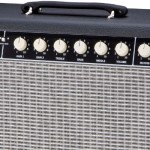Language
How To Improve Your Amp's Maximum "Loudness"
When it comes to getting the very best out of your guitar amplifier, there are few options available designed to increase the overall power of your amp and allow you to turn the knob up to 11. Below are some the more popular option available when it comes to making modifications to your amp and these options are designed to increase the overall perceived “loudness” of the amp.
 Quilter Labs Mach 2 8-inch Combo Amp Review[/caption]
[caption id="attachment_1945" align="alignleft" width="150"]
Quilter Labs Mach 2 8-inch Combo Amp Review[/caption]
[caption id="attachment_1945" align="alignleft" width="150"] Ampeg BA-112 v2 Combo Bass Amplifier Review[/caption]
[caption id="attachment_1995" align="alignleft" width="150"]
Ampeg BA-112 v2 Combo Bass Amplifier Review[/caption]
[caption id="attachment_1995" align="alignleft" width="150"] Great Guitar Amps For Classic Rock[/caption]
Great Guitar Amps For Classic Rock[/caption]
Option 1) FX loop
An effects loop or an FX loop is input/output that allows you to place effects between the pre-amp of the guitar. The pre-amp section of the guitar is where it gets tone and where the power section of the guitar resides – also where the sound is amplified. This means that you can put your pre-amp anywhere in the signal chain as opposed to it being the last stop which increases the overall loudness of the amplifier.Option 2) Master Volume
A master volume basically allows the user to increase the power going to the pre-amp section while controlling the signal going to the power amp. This function is non-existent on a non-master volume amp but can be installed to bypass this function and increase the overall power to the amp which results in a “louder” sound. This option is used best for power tube breakup which does sound different and doesn’t sacrifice on quality.Option 3) MIDI remote interface
By using a MIDI or Musical Instrument Digital Interface, you can wirelessly control amps and equipment through an assortment of specially designed apps. Not only is this option incredibly convenient when needing to access an amp in the dark or adjust tone quickly, you can also increase the overall sound quality and loudness of the amplifier through the remote interface. You can also use additional soundboard application that will make the sound crystal clear and the app also allows you make adjustments on the fly.Option 4) Substitution of electrical components and cones
All amps are built with factory set components and cones and if you are looking to get some added power to your amplifier, you could look to swap out the factory equipped electrical components and speaker cone with higher grade material to give you an added edge. This is only advised if you have done some research on how to properly switch out these components properly because you risk damaging the amp or potentially causing an electrical issue which could result in a fire or meltdown.Option 5) Increased wattage for optimal loudness
You may have heard the cliché that bigger is better? When it comes to amps, that saying can be true depending on the purpose and audience you are intending to play to. Amps come in a range of watts from 15-watt all the way up to 100-watt so when looking at maximum, ear-splitting power coming from your amp, you may want to consider going bigger from the beginning and customising your sound further on down the line. It is easier to go a bit bigger and soften the sound a bit for smaller intimate shows than it is to try everything imaginable to boost the loudness of your existing amplifier. This option may require a bit of trial and error but once you find the sweet spot, you can tailor the power to suit your needs without losing out on distortion or terrible sound quality.Final Thoughts ...
While loudness isn't everything when it comes to rocking out, it definitely doesn't hurt when the situation calls for it! If you feel like your amp could use a dose of extra power, check out these til above and kick things up to 11!Your Turn to Sound Off!
How loud do you tend to play?Let us know in the comment section below!
Other Stories You Might Like ...
[caption id="attachment_7406" align="alignleft" width="150"] Quilter Labs Mach 2 8-inch Combo Amp Review[/caption]
[caption id="attachment_1945" align="alignleft" width="150"]
Quilter Labs Mach 2 8-inch Combo Amp Review[/caption]
[caption id="attachment_1945" align="alignleft" width="150"] Ampeg BA-112 v2 Combo Bass Amplifier Review[/caption]
[caption id="attachment_1995" align="alignleft" width="150"]
Ampeg BA-112 v2 Combo Bass Amplifier Review[/caption]
[caption id="attachment_1995" align="alignleft" width="150"] Great Guitar Amps For Classic Rock[/caption]
Great Guitar Amps For Classic Rock[/caption]
